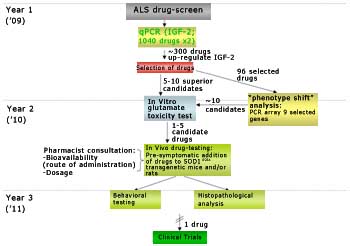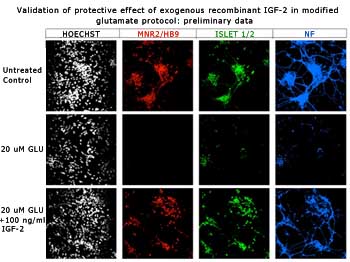Development of Lead Agents for ALS Treatment in Preclinical Model Systems Based on Differential Gene Expression of IGF-II
Posted February 26, 2010
Ole Isacson, M.D., McLean Hospital, Harvard Medical School

Amyotrophic lateral sclerosis (ALS) is a progressive neurodegenerative disease that can be sporadic (the most common form ~ 90% of cases) and familial (hereditary form ~10% of cases). The neurodegeneration affects only somatic motor neurons (MNs) and not autonomic MNs. Studies in ALS mouse models have indicated that the initiation of neurodegeneration might be due to intrinsic factors associated with motor neurons, whereas astrocytes and microglia can also play an important role in the progression of neurodegeneration. Motor neuron subpopulations are prone to relatively differential vulnerability to neurodegeneration with similar pathology and pattern in both forms of ALS, whether sporadic or familial.
Dr. Ole Isacson has taken a novel approach to targeting ALS drug development by examining differential gene expression in subpopulations of motor neurons. He has previously applied this approach successfully in determining neuroprotection biomarkers in Parkinson's disease. His preliminary data from a rat model of ALS highlighted by cranial nerves oculomotor/trochlear (CN 3/4) complex, hypoglossal nerve (CN 12), and lateral motor column (LMC) MNs in symptomatic SOD1G93A rats versus wild-type rats indicated a slight decline of CN 12 MNs and a larger decline in LMC MNs in symptomatic SOD1G93A rats, while CN3/4 MNs seemed to be unaffected. Dr. Isacson then studied global gene and protein expression of CN3/4, CN12, and LMC of the cervical spinal cord in the normal rat. Analysis of in vitro functional assays demonstrated neuroprotective properties of insulin-like growth factor II (IGF-II) when used as a pretreatment for CN 3/4 MNs. IGF-II protected MNs from glutamate toxicity in a validated in vitro bioassay.
Building on these findings, Dr. Isacson, who received an ALSRP FY07 Therapeutic Development Award, has been developing a screening method for identifying compounds that can upregulate expression of IGF-II and that may have neuroprotective properties. High-throughput screening and polymerase chain reactions (PCR) are used to screen drug-like compounds from selected compound libraries (150,000 compounds) featuring many different drug categories. An initial screen of 1,040 generally FDA-approved drugs using quantitative PCR from MN cultures demonstrated 10% of these drugs have a twofold to sixfold upregulation of IGF-II. Notable drug candidates were found in anti-inflammatory, analgesic, and sex hormone-related drug categories. The high-hit compounds were further evaluated and selected by enhancement of IGF-II-related pathway phenotypes and by an in vitro glutamate toxicity assay, a validated bioassay for vulnerability to excitotoxic neuronal degeneration or MN death common in ALS.
Preliminary analysis of pharmacological and toxicological profiles of the selected candidate drugs are in progress both in vitro and in vivo. Additionally, selected candidate drugs with previously known brain permeability are being examined in both normal and pre-symptomatic SOD1G93A rats and mice for disease progression, behavioral and histopathological analysis. A larger screen of drug compounds with structural analysis and pharmacological and toxicological profiles in animal models will follow. The result of the large study will be an optimized candidate drug with high translational potential to be used as a first-line drug for ALS treatment.
Selected Recent Publications:
Chung CY, Koprich JB, Hallett PJ, and Isacson O. 2009. Functional enhancement and protection of dopaminergic terminals by RAB3B overexpression. Proc Natl Acad Sci U S A. 106(52):22474-22479. [Epub 2009 Dec 10.]
Isacson O. 2009. Cell therapy ahead for Parkinson's disease. Science 326(5956):1060.
Pruszak J, Just L, Isacson O, and Nikkhah G. 2009. Isolation and culture of ventral mesencephalic precursor cells and dopaminergic neurons from rodent brains. Curr Protoc Stem Cell Biol Chapter 2:Unit 2D.5.
Hedlund E and Isacson O. 2008. ALS model glia can mediate toxicity to motor neurons derived from human embryonic stem cells. Cell Stem Cell 3(6):575-576. Review.
2010 Amyotrophic Lateral Sclerosis Research Highlights
















